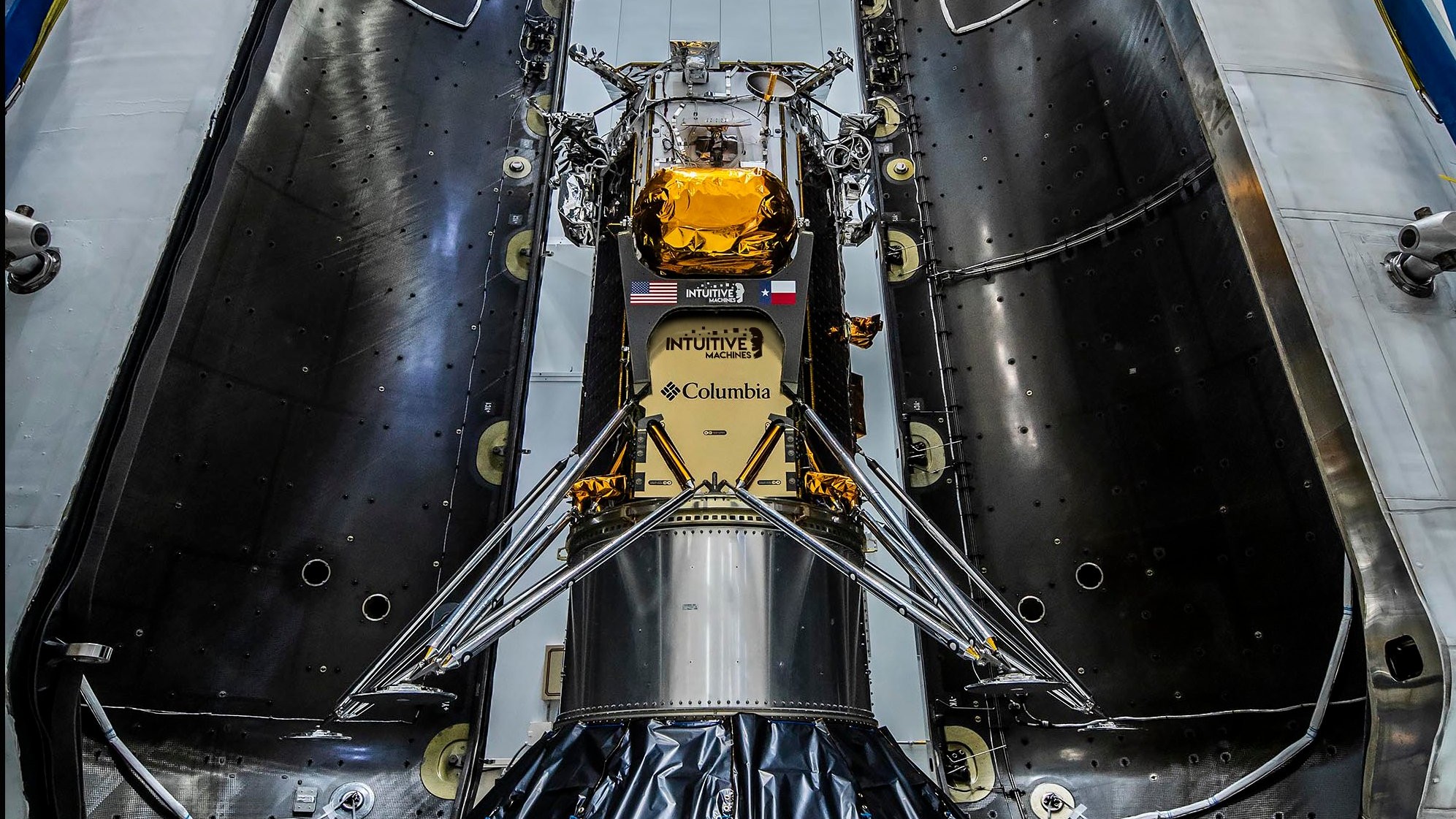SpaceX to launch Intuitive Machines lander Feb. 15 on 2nd try for NASA's commercial moon program
Liftoff of the IM-1 mission is scheduled for 1:05 a.m. ET on Thursday (Feb. 15).

Update for Feb. 14: SpaceX is now aiming to launch the IM-1 moon lander mission for Intuitive Machines no earlier than Thursday, Feb. 15, due to a liquid methane temperature issue during preparations to fuel the Odysseus lander. You can read our story and see the updated times for the mission below.
Early Wednesday morning (Feb. 14), Intuitive Machines will kick off its quest to become the first private company to make a soft landing on the lunar surface.
The Houston-based company is launching its Nova-C lander, named "Odysseus," to the moon atop a SpaceX Falcon 9 rocket from NASA's Kennedy Space Center in Florida. Liftoff is currently scheduled for 12:57 a.m. EST (0557 GMT) on Wednesday, Valentine's Day. The mission was originally slated to launch in January, but bad weather pushed it to this month.
SpaceX has a three-day window in which to launch the mission, known as IM-1, in order to reach its target to land on the moon on Feb. 22. But those other two days may not be necessary, for everything looks good for a Wednesday liftoff.
"SpaceX, and team members from SpaceX, are tremendously proud to be part of this historic mission," Bill Gerstenmaier, SpaceX's vice president of build and flight reliability, said during a press conference today (Feb. 13). "We're ready, and we're ready for whatever comes in the days ahead."
NASA will provide a livestream of the launch beginning at 12:15 a.m. EST (0515 GMT) that will be broadcast on NASA TV, the agency's NASA+ streaming channel and its website. Space.com will host a simulcast of NASA's webcast on our homepage, the top of this page and likely our YouTube channel as well.
Get the Space.com Newsletter
Breaking space news, the latest updates on rocket launches, skywatching events and more!
Read more: How to watch SpaceX launch the private Intuitive Machines moon lander IM-1 on Feb. 14 live online
On Feb. 22, Odysseus will attempt to touch down near Malapert A, a companion crater close to the 43-mile-wide (69 kilometers) Malapert Crater, which lies near the moon's south pole. If it survives the landing, the probe will remain active on the lunar surface for about a week, until the frigid lunar night sets in at its locale.
Odysseus is carrying six scientific experiments for NASA and six payloads for commercial customers. The partnership with NASA marks the second time the agency has sent science payloads toward the moon aboard a private spacecraft as part of its Commercial Lunar Payload Services program, or CLPS.
The first CLPS payloads flew aboard Astrobotic's Peregrine lander that launched on Jan. 8, 2024 on the debut mission of United Launch Alliance's Vulcan Centaur rocket. Shortly after deploying from Centaur's upper stage, however, Peregrine suffered an anomaly and eventually fell back to a fiery end in Earth's atmosphere.
Hopefully, the second CLPS mission will fare better than the first. Some of the payloads Odysseus will carry to the moon for NASA include a laser reflector array that will serve as precision landmarks for future landers; a new LIDAR-based sensor to test new landing techniques; tiny cameras to study the interaction between the lander's exhaust plume and the lunar surface; a radio navigation beacon that will help test autonomous landing and positioning techniques; and Radio Observations of the Lunar Surface Photoelectron Sheath, or ROLSES, which will measure the electromagnetic conditions on the lunar surface.
The private payloads aboard Odysseus include a special insulative material experiment developed in conjunction with Columbia Sportswear, a sculpture series by artist Jeff Koons, and a "secure lunar repository" developed by the Arch Mission that carries works of literature and historical archives.
CLPS missions like IM-1 are helping to pave the way for NASA's ongoing Artemis program that aims to establish a sustainable human presence on the moon. A number of these commercial missions will help lay the groundwork for future NASA moon landings by building a network of infrastructure on the lunar surface to be used by Artemis astronauts, agency officials have said.
Join our Space Forums to keep talking space on the latest missions, night sky and more! And if you have a news tip, correction or comment, let us know at: community@space.com.

Brett is curious about emerging aerospace technologies, alternative launch concepts, military space developments and uncrewed aircraft systems. Brett's work has appeared on Scientific American, The War Zone, Popular Science, the History Channel, Science Discovery and more. Brett has English degrees from Clemson University and the University of North Carolina at Charlotte. In his free time, Brett enjoys skywatching throughout the dark skies of the Appalachian mountains.









